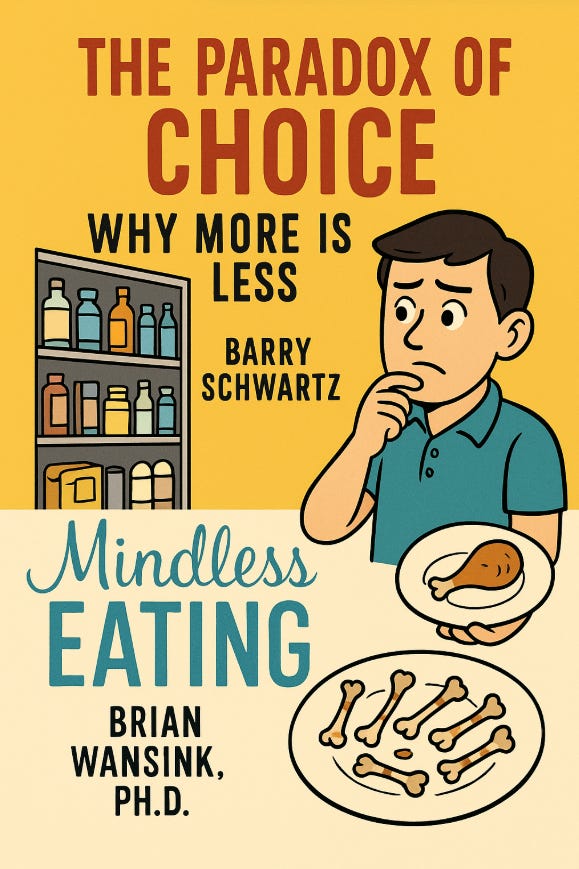Embrace Mindlessness
How The Paradox of Choice and Mindless Eating Show How Structures Can Beat Willpower

On one hand we want to have options, and on the other hand too many options is overwhelming. Today I want to share a summary of two books I’ve found helpful for understanding how structures can help us navigate that tension more elegantly.
The Paradox of Choice
The fact that too many options can leave us paralyzed, anxious, and regretful is the central thesis of Barry Schwartz’s The Paradox of Choice—and it’s backed up not just by psychological research, but by anyone who’s spent 45 minutes scrolling Netflix and still ended up watching nothing.
And it’s not just decision fatigue. In Mindless Eating, Brian Wansink shows that our environment—the plate size, the lighting, even whether we can see our past food waste—can radically shape how much we eat, without us ever noticing.
Both books point to the same idea: we overestimate our conscious decision-making and underestimate the power of structure. In The Paradox of Choice, Schwartz distinguishes between two decision-making styles:
Maximizers seek the best possible option. They want to be sure they’ve made the optimal choice.
Satisficers (that’s not a misspelling) seek a “good enough” option that meets their criteria.
While maximizing sounds wise, research shows it often leads to lower satisfaction. Maximizers second-guess, ruminate, and tend to feel regret—especially when there are dozens or hundreds of options to consider.
Example: Think of shopping for jeans. In a study Schwartz describes, participants who had more options available actually ended up less satisfied with their purchase, even if they got a “better” pair.
This is the paradox: more choice creates more opportunity, but also more stress, indecision, and dissatisfaction.
Mindless Eating
Wansink’s research shows that our choices around food are rarely rational. They’re often dictated by cues we barely notice. Like…
Plate size: People eat less when given smaller plates, without feeling less full.
Visible leftovers: In one study, people at a chicken wing buffet ate significantly less when the bones were left on the table—compared to when the server cleared them away as they ate.
Bottomless soup bowls: In a devilish experiment, bowls were rigged to slowly refill from the bottom. People ate 73% more soup than normal—without realizing it.
These aren’t stories of willpower failure. They’re stories of structure. When the environment is set up a certain way, people make very different decisions. Not because they decided differently—but because the decision was shaped differently to begin with.
The Structure-Orientation
If you’ve followed my work, you know I’m deeply interested in how structures—explicit, ongoing, prescriptive expectations like rules and agreements—shape our behavior.
The Paradox of Choice and Mindless Eating aren’t about collaboration or self-management per se, but they illustrate something profound: the quality of our outcomes is often less about willpower or values, and more about the design of our environment.
That’s what I mean when I say structure can be freeing. Not because it forces people—but because it frees up mental effort, makes good behavior easier, and lowers the hidden tax of endless choice.
So the next time you’re tempted to “just be more disciplined,” consider changing the plate size instead.
Hey subscribers!
In an effort to have more discussions about collaboration and communication, I’ll be hosting a monthly office hour in Zoom every 4th Wednesday starting August 27th from 10am-11am EDT.
Meaning, the first one will be in just two days, so I hope to see you there. It will be a general open space for discussion, questions, and curiosities.
Figuring out how to work better together, not surprisingly, is a group effort and I really value your thoughts and perspectives as well as your questions.
Again, the open office hour will be every 4th Wednesday starting August 27th from 10am-11am EDT at this link:
https://us06web.zoom.us/j/84636176366?jst=2
Feel free to share the link with anyone else you think might be interested.
Finally, I’ll be hosting regular Substack Live events discussing a variety of topics, so stay tuned for the topic for my next Substack Live which will be happening on Wednesday September 3rd at 10am EDT (no link needed for that).

